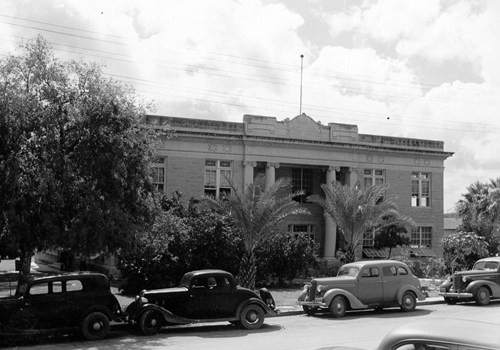|
|
Texas
has always remained close to its Mexican heritage. Just how close
that can be in some of the most southern of our 254 counties can at
times bewilder even a fellow Texan from a more northern county.
Dimmit county is one of the most southern counties. The name, as I
understand it, was meant to honor a Pennsylvania adventurer named
Phillip Dimmitt who fought for Texas’ independence from Mexico. Dimmitt
had gone unheralded and unrecognized for his brave deeds, so someone
decided to correct the oversight by naming a rural, rather unpopulated
county after him. However, no one could remember how to actually spell
his name, so Dimmit it was…and still is.
Ironically, the independence from Mexico Phillip Dimmitt fought for
so valiantly has slowly been diluted in his namesake county until
today he might well wonder if it was worth the trouble.
The Dimmit county seat is Carrizo
Springs, a Mexican name for the reeds surrounding the natural
springs there.
Over barbecue one day, a friend, Dave Ralston, one of Navarro County’s
most respected attorneys and a great teller of tales shared a story
with us. In his 54 plus years of experience, Dave served as county
judge and city attorney as well as maintaining a busy private practice,
so he certainly knew the law and how to navigate complicated legal
situations. He had traveled to distant Carrizo
Springs for a hearing on a motion he had filed to transfer venue
(or location of the case) to Navarro County. |
 |
|
When Dave entered
the Carrizo
Springs courtroom however, he knew there was a problem. No one,
the bailiff, attorneys, secretaries, spectators, or the judge…no
one was speaking English. They were all conversing vigorously in
Spanish. Dave, whose command of the Spanish language was limited
mostly to menus, waited for the proceedings to make sense to him.
Eventually, he heard words that he recognized, the name of his case
being called. He put his head down, strode to the counsel table
and prepared to plead his motion to the judge. He unpacked his briefcase
and laid out his papers. Then, waited.
The rapid-fire Spanish continued, but eventually Dave again heard
his case title mixed in among the Spanish. The judge glanced at
him. Dave rose to his feet. “I object, your honor. It’s my understanding
that the rules of procedure require proceedings in courts in the
state of Texas be conducted in English.”
The judge looked over his glasses at Dave. “Mr. Ralston, this is
my court and I will conduct proceedings in my court in any language
I choose. And I choose Spanish. Sit down, Mr. Ralston. I’ll tell
you if anything important happens that you need to know. In English.”
Dave just stood, his mouth open. “Your honor…”
“Sit down, Mr. Ralston.”
So sit he reluctantly
did, while opposing council, the judge and several others argued
vociferously and interminably in Spanish. (He wondered absently
if he should have taken a Spanish class in school.) From time to
time, they glanced in Dave’s direction but other than that appeared
oblivious to his presence. Dave raised a finger once, but the judge
stared it down.
Suddenly, the judge banged his gavel. “Motion granted.”
Leaning toward Dave, the judge said, “See, Mr. Ralston. I told you
I would let you know if anything important happened. In English.”
© Dianne West
Short
May 2, 2014 Guest Column
Related
Topics:
Texas Courthouses
| People
| Columns | Texas
Town List | Texas
|
| Texas
Escapes, in its purpose to preserve historic, endangered
and vanishing Texas, asks that anyone wishing to share their local
history, stories, and vintage/historic photos, please contact
us. |
|
|